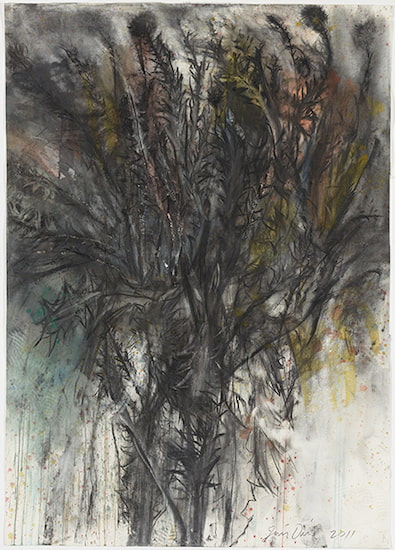Jewish American Heritage Month: Jim Dine
I will wrap up Jewish American Heritage Month with a great artist who has transcended the label “Pop Art” in brilliant ways in his art. Jim Dine emerged from the generation of American Pop artists, but avoided their glorification of impersonal consumer products. Dine invests his art with autobiographical elements. Of Lithuanian, Polish, and Hungarian Jewish origin, Dine has had studios near Paris, France; in Göttingen, Germany; in New York; and in Walla Walla, Washington. The artist considers his “Yiddishkeit” as part of the inspiration in his art.
 |
| Jim Dine (born 1935, United States), Thistle, 2011. Charcoal, pastel, and watercolor on paper, 6'3" x 3'9" (183.5 x 111.8 cm). Philadelphia Museum of Art. © 2025 Jim Dine / Artists Rights Society (ARS), New York. (PMA-8462diars) |
In the 1970s, Dine began drawing from life, working repeatedly on the same subjects to record subtleties that emerge from direct, deep observation. Around the same time, he began drawing plants, a practice that persists to the current day. His drawing process is one of continual revision, working and reworking the image until it is barely recognizable. The artist considers this process the "history" of the drawing.
An English critic coined the term Pop Art as early as 1958 to describe a late-1950s art movement in England that parodied popular culture. However, Pop Art had its greatest impetus in the United States in the 1960s. Pop art was embraced by a young generation of artists who matured in the 1950s and rejected the domination of Abstract Expressionism as overly philosophical and not readily accessible to the public.
In rejecting the action painting of Jackson Pollock (1912–1956) and Willem de Kooning (1904–1997), Pop artists turned their attention to subject matter recognizable to the American public. Such subject matter was usually treated in a deadpan manner. It was often given an unexpected twist, presenting an irony and mockery reminiscent of the found objects of Marcel Duchamp (1887–1968). Pop Art was often referred to as Neo-Dada in the early 1960s. Although Pop artists emphasized subject matter, they worked in a wide variety of styles. Thus, Pop Art was not so much a style as it was an aesthetic.
Born in 1935 in Cincinnati, Ohio, Jim Dine studied painting at the University of Cincinnati and at the Boston School of Fine and Applied Arts in Boston, Massachusetts. His parents owned a hardware store, to which he attributes an early appreciation for ordinary objects. In 1953, he studied painting at the Art Academy of Cincinnati under an Abstract Expressionist artist, but he ultimately rejected that influence, although the painterly aspect of the style would affect his later work. In 1957, he received a Bachelor of Fine Arts degree from Ohio University, Athens, and moved to New York in 1959.
Becoming acquainted with Claes Oldenburg (1929–2022) and John Cage (1912–1992), Dine became involved in the burgeoning performance art scene with them. He staged his first Happenings (gallery performances) with Oldenburg and Allan Kaprow (1927–2006) at the Judson Gallery in New York. In 1962, Dine's inclusion in the ground-breaking proto-Pop show, New Paintings of Common Objects, secured his reputation in the new movement.
In the 1970s, Dine chose to focus on drawing in an attempt to continue his investigation of everyday objects in a less controversial manner than his "tool" paintings of the 1960s. The 1970s was the period of a series of still-life studies. He also produced series on such Pop-related subjects as bathrobes, painters' palettes, and hearts.
Correlations to Davis programs: Explorations in Art 2E Grade 1: 1.2, 4.2; Explorations in Art 2E Grade 2: 1.2, 1.3; Explorations in Art 2E Grade 3: 6.4; Explorations in Art 2E Grade 5: 4.1, 4.2, 4.3; Experience Art: 4.2; Discovering Drawing 3E: Chapter 3; The Visual Experience 4E: 4.9; Davis Collections: Still Life

Comments